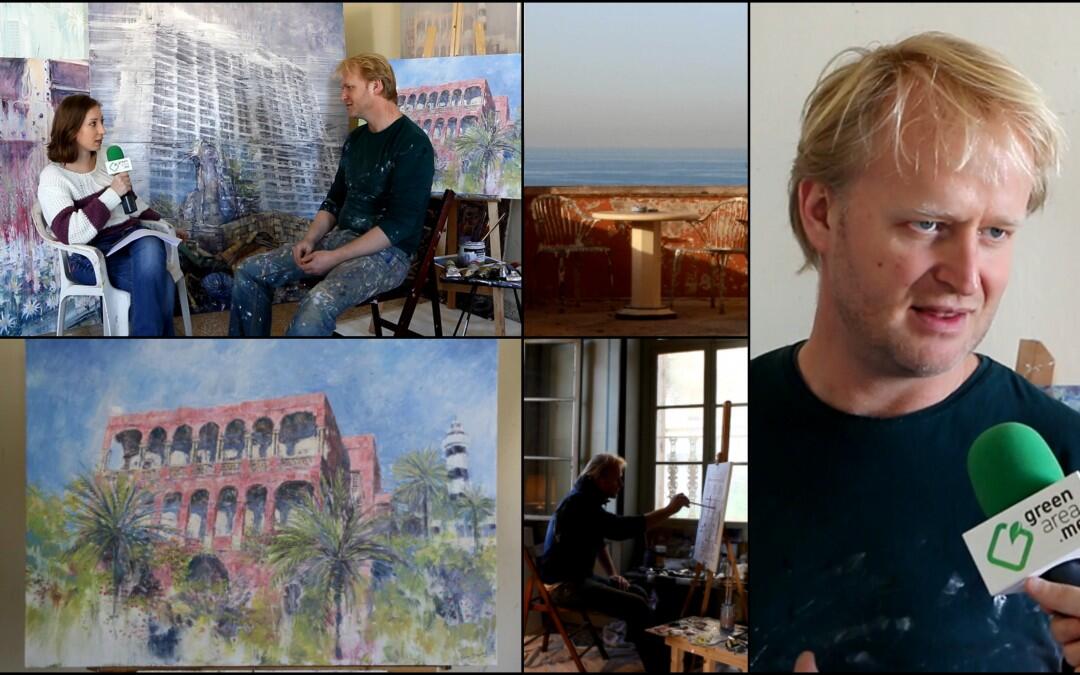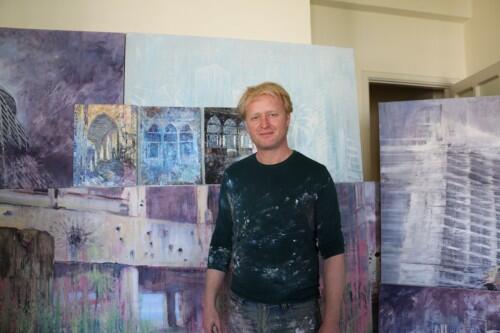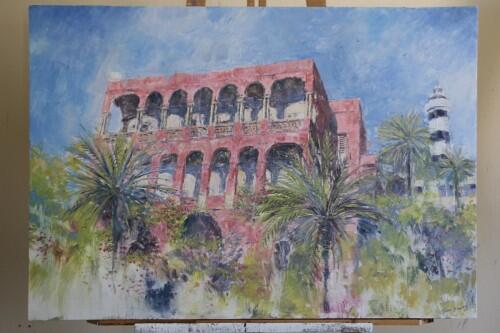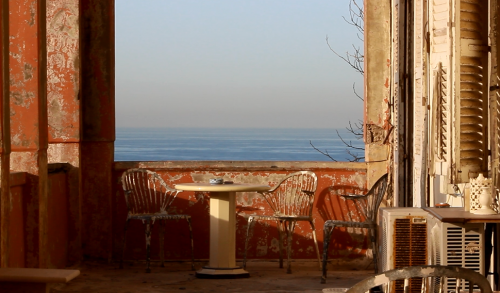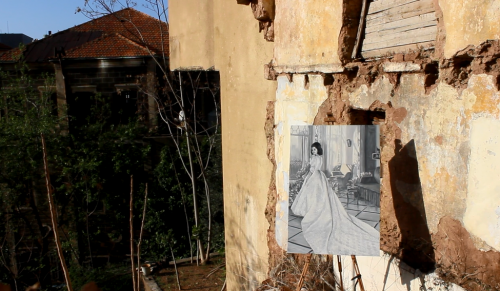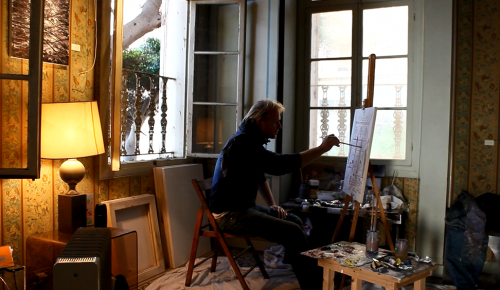Tom Young, through his art, is trying to raise awareness on preserving old cultural buildings and public spaces, for they are the real identity of Beirut. Greenarea.me interviewed the artist who finds comfort and inspiration in Lebanon, despited traveling all around the world. This country has a lot to do with cultural memory, which is slowly being lost, he told us, in an inspiring discussion in his private studio. All about the “Fairy-Tale Rose House” he painted in Ain El-Mrayseh, and other paintings in an emotional talk about Lebanon and the architectural mixture it holds… It’s about a real identity of a city…
You’ve been painting the pink house in Ain el-Mraiseh in Beirut. What drove your interest to paint that house? What did you find special about that house in particular?
I’ve always loved the house ever since my first visit to Lebanon, which was in 2006, and it is such a magical and unique place, especially by the way it overlooks the sea. It is so unique by the way it is surrounded by those huge towers going up, and still standing strong. I’ve always been fascinated by it, but I felt in 2014 was the right time to knock on the door. So, with my wife, we went up and found the back door. I asked if we could meet the owner or the resident, and I eventually met her, and she was a very inspiring lady, Fayza al Khazen, and her family had lived in the building for the past 50 years.
She invited me, and I started painting, simply because I found the place so magical and unique. It’s like a fairytale house.
Also, before going to the rose house or the pink house, I had done a project in Jemmayzeh in a place called Villa Paradiso. Villa Paradiso also was a beautiful mansion which was abandoned ever since the civil war in Lebanon, and I thought it would be amazing place to paint and maybe to do an exhibition. With the owners, the Feghali family, we renovated the house and converted it into an exhibition venue, and I did my exhibition.
So, I was so inspired by these places, and I still am. There’s a real issue in Lebanon, that a lot of this heritage is being destroyed; not just the precious historical identity of Lebanon, but also public space places for the public to meet, This is extremely being privatized and becoming like a big set of concrete compounds for the wealthy. We are losing places where we can meet in a cultural setting.
Do you think that through painting these places and painting the people that used to live in them, you convey more the culture that they reveal or symbolize? Do you think it’s a way of preserving such cultural places?
I think that memory is a very important issue in my work. I think that a lot of memory is being wiped away in Lebanon and forgotten. Memory both is terms of architecture which is being destroyed, and memory of the people who used to live in these places, because in the end, buildings are really nothing without the people that used to live in them.
So, when I do my exhibitions in these deserted buildings, I try to bring them alive with the human story behind the buildings (who built them, who lived in them, what kind of stories happened here), and it means that my work is not just about me and what I want to express, it’s about a wider issue about a city’s memory, and I think that this is extremely important to celebrate this and to remember what happened. In this way, the buildings come alive for people. People can feel an attachment to them, and I think that this is really important in the process of preserving what little is left.
This is a commission painting which I’ve done recently since my exhibition lately in the house. Since my exhibition in the house, I’ve continued to paint it.
I’ve just missed the building so much, that painting is a way for me to continue my relationship with this beautiful building. This was a commissioned painting. What is so beautiful about the rose house for me is not just the house, but the fact that it is surrounded by this beautiful garden, which is very rare in Beirut. So many of the green spaces and gardens are being destroyed and wiped away.
Who is destroying the gardens near the pink house now in Ain El Mreiseh?
No one is destroying them now. The garden around the rose house is being preserved now. There are plans for the house to be renovated.
Hicham Jaroudi, who kindly let me have access to the building for many months, for me to do my exhibition, has plans to renovate it, but I gather that there is a legal issue with someone who still part-owns the building, who is blocking the process. I am a bit worried because the building is falling to pieces, and something needs to be done very quickly, because otherwise it’s going to just crumble. There are big structural cracks on the top floor, and that was one of the reasons why my exhibition had to end. Structural engineers assessed the building and said that maybe it is not safe for the public anymore. Anyway, I still love to paint the beauty of it. There’s a sense of urgency that perhaps these places will not survive for much longer.
Did you feel that there are still people in Lebanon who are worried about these cultural places, and interested in preserving them?
There are plenty of people in Lebanon who really care about this issue of preserving heritage and public spaces. The organization “Save Beirut Heritage” and the architect Mona Hallak who is pioneering the “Beit Beirut” project, is very inspiring. The Feghali family, who I did Villa paradise with, they are an example of a very cultured family, are property developers, but they really care about Lebanese heritage. We created this cultural venue which lasted for 2 or 3 years. They’re renovating a bit more, and it might be the private residence of the European commission in Lebanon.
Of course there is a great need for modern buildings in the right place. For example, in the starco area, that’s the place for the great towers and for the business district. I’m not against that, but I think that new development has to be done in the right way, in the right context. Places which still have gardens, places which have these beautiful buildings should be maintained and respected.
When I did the rose house exhibition and the Villa Paradiso, there was overwhelming public interest in these projects. So many people came, and most of them were Lebanese. The fact that this precious place was open to the public as well, that’s very important as well. Ordinary people should have access to these places, and art is a great way to make these buildings open to everybody.
I hear that there isn’t much care for heritage here, but in my experience, this is complete rubbish, people care a lot.
What did you find different about these historic places in Lebanon, which is different from any other place in the world?
That’s quite difficult to explain. It’s a feeling I feel for Lebanon. The best way to answer that is by looking at my paintings. I’ve traveled all over the world and worked all over Europe, India, Africa, America, but I’m particularly inspired by Lebanon. I think it’s really because it touches an emotional part of me. There is a great sense that memories are being wiped away here. There is a sense of loss, and a sense of urgency to do something and to act. I feel this much more strongly in Lebanon more than any other country. Lebanon’s a unique mixture of east and west. It’s very unique, and that’s what Lebanon is in the world, it’s full of different influences. It makes the architecture very unique.
I feel very free to express myself here, and because I really love the place, I want to give something back.
Twitter: @Zeina_W_Nasser
What are your views on cultural buildings and public spaces? Share your opinion on our Twitter account @greenareaen

